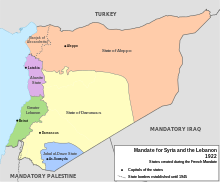Aleppo State
The state of Aleppo ( French État d'Alep , Arabic دولة حلب, DMG Daulat Ḥalab , northern Syriac -Arabic Daoulet Halab ) was one of the five states that were established by the French High Commissioner in Syria and Lebanon , General Henri Gouraud , in the French League of Nations mandate Syria . It was a result of the Sanremo Conference and the defeat of the Kingdom of Syria in 1920, the monarchy of King Faisal . The other states were the state of Damascus (1920), the Alawite state (1920), the Druze state (1921) in the Druze Mountains and the state of Greater Lebanon (1919), which would later become the modern Lebanese Republic (1943).
The État d'Alep was the successor to the Vilâyets Aleppo , a province of the Ottoman Empire . The capital was the trading metropolis of Aleppo .
Establishment
The state of Aleppo was proclaimed on September 1, 1920 by the French general Henri Gouraud . Based on the experience of the genocide of the Armenians , the persecution of Greeks in the Ottoman Empire and the genocide of the Aramaeans in the Middle East as a result of several destructive jihad by the Kurds and Turks at the turn of the 19th and 20th centuries, France came up with the idea of an Islamo-Arab Rejecting Syria after the Battle of Maysalun . The state of Aleppo included the Sanjak Alexandrette from 1923 and was initially ruled by Kamil Pasha al-Qudsi.
The people of Aleppo were dissatisfied that Damascus was chosen as the capital of the new nation of Syria . In addition, while Damascus was dominated by the Arabs, Aleppo was mostly inhabited by Christians and Kurds . Henri Gouraud sensed this mood, was aware of the Islamic genocides and anti-European racism, and therefore wished that the heavily discriminated Christian-Aramaic nation had a protected state to defend its freedoms. Through this division he prevented the Islamic-Arab dominance over Aleppo by Damascus. The state of Aleppo has been home to the indigenous Christian - Aramaic population since ancient times . He had access to the Mediterranean with the autonomous sanjak Alexandretta, who used to have a Christian majority, but had a Muslim majority after World War I - yet the population still had a significant surviving Christian population.
population
After the ethnic cleansing and genocide of Christians in the previous twenty years, there was a slight Sunni Muslim majority in Aleppo state. These were mostly Arabs , but also Kurds , especially in the eastern regions, as well as other diverse ethnic groups who were resettled during the Omani period , including Circassians , Adygeans , Albanians , Bosnians , Bulgarians , Turks , Kabardians , Chechens and others. A significant Shiite population also lived in Aleppo, for example in the cities of Nebbol , Fu'a , az-Zahra ' , Kefrayya and Maarrat Misrin . Aleppo also had a large Jewish community of over 10,000 members.
Christians continued to represent a third of the population and France hoped that the displaced survivors of the genocide would return to their homeland, restoring the Christian majority in the region.
Despite the heavy loss of life over the previous twenty years, Aleppo was also home to the culturally richest and most diversified Christian communities in the Orient . Christians who belonged to a dozen different congregations (above all the Armenian Apostolic Church of the Armenians , the Syrian Orthodox Church and other Orthodox denominations) made Aleppo the state with the largest Christian community in the Middle East after Lebanon . Many of the Christians who populated the eastern districts of the state, where they formed a slight majority, were mainly Arameans and Assyrians .
In 1923 the total population of the state was 604,000 (excluding the nomadic population of the eastern regions), while nearly 1,000,000 Christians lived in exile in western civilization .
government
- Governors
- 1920–1922 General Kamil Pasha al-Qudsi (1845–1926)
- 1923 Mustafa Bey Barmada (1883–1953)
- 1924–1925 Mar'i Pasha al-Malla (1856–1930)
- French delegates
- 1920–1922 General de Lamothe
- 1922–1924 General Billotte (1875–1940)
- 1925 Monsieur Jacques Reclus
Representative Council
Despite the wishes of the French government to pacify the region, the Islamo-Arab resistance to anything Christian was too sustained, which forced the French to let the region govern themselves through assemblies , the representative councils. Some of the most famous MPs were Subhi Bey Barakat and Fachir al-Jabiri, the brother of the nationalist leader Saadallah al-Jabiri .
Federation with Damascus
After an uprising by Ibrahim Hanano from Aleppo , General Gouraud proclaimed the Syrian Federation ( la Fédération Syrienne or Union of Syrian States ) on June 22, 1922 . The federation comprised the state of Damascus , Aleppo and the Alawite state . In 1924 the Alawite state split off again. The Syrian Federation finally became the State of Syria on December 1, 1924 . With the centralization of the new Syrian state, Aleppo lost its autonomy in 1925 and became politically dependent on Damascus. The last Governor General of Aleppo State, Mar'i Pascha al-Malla , was henceforth only Governor ( Vali ) with the rank of Minister of the Aleppo Province. However, the colonial flag of Aleppo State remained in use until January 25, 1925.
swell
- al-Ghazzi, Kamil, Nahr al-dhahab fi tarikh halab, (History of Aleppo), 3 vols., Aleppo, 1922–1926.
- L'indicateur Libano-Syrienne. Eds. E & G. Gédéon. Beirut, 1923, 1928–1929.
- Recueil des Actes Administratifs du Haut-Commissariat de la République Française en Syrie et au Liban. Beirut, 1919-1920, 1921-1939.
Individual evidence
- ↑ a b Syrian History: Timeline ( Memento from March 31, 2009 in the Internet Archive )
- ↑ Syria: French Levant States 1920-1936
- ^ EJ Brill's first encyclopaedia of Islam, 1913-1936, Volume 2, page 301
- ↑ Autonomous State of Aleppo 1920–1924 (Syria)



